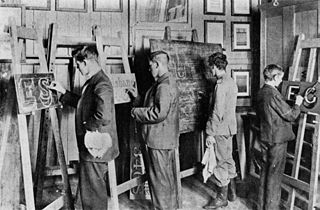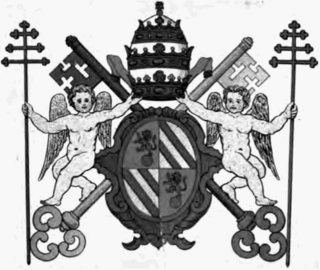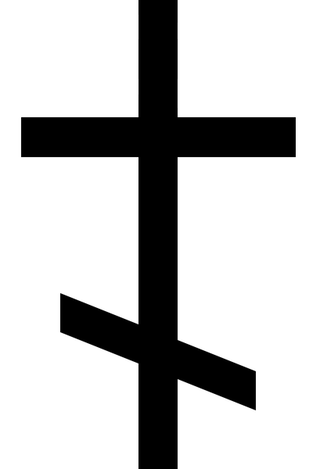
Gaelic football, commonly known as simply Gaelic, GAA or Football is an Irish team sport. A form of football, it is played between two teams of 15 players on a rectangular grass pitch. The objective of the sport is to score by kicking or punching the ball into the other team's goal or between two upright posts above the goal and over a crossbar 2.5 metres above the ground.

In electronics and telecommunications, a crossbar switch is a collection of switches arranged in a matrix configuration. A crossbar switch has multiple input and output lines that form a crossed pattern of interconnecting lines between which a connection may be established by closing a switch located at each intersection, the elements of the matrix. Originally, a crossbar switch consisted literally of crossing metal bars that provided the input and output paths. Later implementations achieved the same switching topology in solid-state electronics. The crossbar switch is one of the principal telephone exchange architectures, together with a rotary switch, memory switch, and a crossover switch.
Although people in many parts of the world share common alphabets and numeral systems, styles of handwritten letterforms vary between individuals, and sometimes also vary systematically between regions.

An easel is an upright support used for displaying and/or fixing something resting upon it, at an angle of about 20° to the vertical. In particular, painters traditionally use an easel to support a painting while they work on it, normally standing up; easels are also sometimes used to display finished paintings. Artists' easels are still typically made of wood, in functional designs that have changed little for centuries, or even millennia, though new materials and designs exist. Easels are typically made from wood, aluminum or steel.

In sport, a goal may refer to either an instance of scoring, or to the physical structure or area where an attacking team must send the ball or puck in order to score points. The structure of a goal varies from sport to sport, and one is placed at or near each end of the playing field for each team to defend. For many sports, each goal structure usually consists of two vertical posts, called goal posts, supporting a horizontal crossbar. A goal line marked on the playing surface between the goal posts demarcates the goal area. Thus, the objective is to send the ball or puck between the goal posts, under or over the crossbar, and across the goal line. Other sports may have other types of structures or areas where the ball or puck must pass through, such as the basketball hoop. Sports which feature goal scoring are also commonly known as invasion games.

In ice hockey, a goal is scored when the puck entirely crosses the goal line between the two goal posts and below the goal crossbar. A goal awards one point to the team attacking the goal scored upon, regardless of which team the player who actually deflected the puck into the goal belongs to. Typically, a player on the team attempting to score shoots the puck with their stick towards the goal net opening, and a player on the opposing team called a goaltender tries to block the shot to prevent a goal from being scored against their team.

The Patriarchal cross is a variant of the Christian cross, the religious symbol of Christianity, and is also known as the Cross of Lorraine. Similar to the familiar Latin cross, the patriarchal cross possesses a smaller crossbar placed above the main one so that both crossbars are near the top. Sometimes the patriarchal cross has a short, slanted crosspiece near its foot. This slanted, lower crosspiece often appears in Byzantine Greek and Eastern European iconography, as well as in other Eastern Orthodox churches. In most renditions of the Cross of Lorraine, the horizontal bars are "graded" with the upper bar being the shorter, though variations with the bars of equal length are also seen.
The Crossbar latch is a technology published by Phillip Kuekes of HP Labs in 2001 and granted a US patent in 2003, with the goal of eventually replacing transistors in various applications. This would enable the creation of integrated circuits composed solely of memristors, which, according to the patent, might be easier and less expensive to create. In 2005, Phillip Kuekes stated that the crossbar latch "could someday replace transistors in computers, just as transistors replaced vacuum tubes and vacuum tubes replaced electromagnetic relays before them."

The papal cross is a Christian cross, which serves as an emblem for the office of the Pope in ecclesiastical heraldry. It is depicted as a staff with three horizontal bars near the top, in diminishing order of length as the top is approached.

A football pitch is the playing surface for the game of association football. Its dimensions and markings are defined by Law 1 of the Laws of the Game, "The Field of Play". The pitch is typically made of natural turf or artificial turf, although amateur and recreational teams often play on dirt fields. Artificial surfaces are allowed only to be green in colour.

Đ, known as crossed D or dyet, is a letter formed from the base character D/d overlaid with a crossbar. Crossing was used to create eth (ð), but eth has an uncial as its base whereas đ is based on the straight-backed roman d, like in Sámi Languages and Vietnamese. Crossed d is a letter in the alphabets of several languages and is used in linguistics as a voiced dental fricative.

The North–South–East–West r (NS-EW) is the largest ongoing highway project in India. It is the second phase of the National Highways Development Project (NHDP), and consists of building 7300 kilometers of four/six lane highways associating Srinagar, Kanyakumari, Kochi, Porbandar and Silchar, at a cost of US$12.317 billion ₹1000000000000(One lakh Crore INR). As of 19 March 2024, 6875 of the 7142 kilometers project has been finished.

The Octopus is a type of amusement ride in the shape of an octopus. Six to eight arms attached to a central axis of rotation and move up and down in a wavelike motion via a counter rotating eccentric, while cars at the end of the arms, either attached directly to the arm or fixed on spinning crosses, spin freely or stay in place, depending on the exact type of ride. Each Octopus ride has the arms attached the middle of the ride. The middle or centric of the ride will move somehow. Most octopus rides require guests to be at least 42 inches to ride without an adult; smaller children must have an adult with them. This is a regular at the annual AGS and AHS fairs in Ateneo de Manila University
The Number One Crossbar Switching System (1XB), was the primary technology for urban telephone exchanges served by the Bell System in the mid-20th century. Its switch fabric used the electromechanical crossbar switch to implement the topology of the panel switching system of the 1920s. The first No. 1 Crossbar was installed in the PResident-2 central office at Troy Avenue in Brooklyn, New York which became operational in February 1938.
The Imperial helmet-type was a type of helmet worn by Roman legionaries. Prior to the Empire, Roman Republican soldiers often provided their own equipment, which was passed down from father to son. Thus, a variety of equipment, from different eras was present in the ranks. Even as the professional Imperial army emerged, and short-term service citizen soldiers became rare, useful equipment was never discarded. So when the improved Imperial helmet appeared, it replaced what remained of the very old Coolus type, which was largely superseded at the time by improved versions of the Montefortino helmet type, which continued to serve alongside it for a time. This constituted the final evolutionary stage of the legionary helmet (galea).
TXK was a range of Crossbar exchanges used by the British Post Office telephone network, subsequently BT, between 1964 and 1994. TXC was used as the designation at first, but this was later changed as TXC sounded too much like TXE the code used for later electronic exchanges. Prior to this the GPO had standardised on Strowger for automatic switching and had resisted the adoption of Crossbar, preferring to wait for its electronic switching research to bear fruit. The development of electronic systems however took longer than anticipated and the British equipment manufacturers, particularly Automatic Telephone & Electric (ATE), which later became part of the Plessey group feared that continuing to focus the bulk of their production on Strowger equipment would harm their export sales as Crossbar had already become popular throughout the world.

A telephone exchange, also known as a telephone switch or central office, is a crucial component in the public switched telephone network (PSTN) or large enterprise telecommunications systems. It facilitates the interconnection of telephone subscriber lines or digital system virtual circuits, enabling telephone calls between subscribers.

Jehohanan was a man put to death by crucifixion in the 1st century CE. His ossuary was found in 1968 when building contractors working in Giv'at ha-Mivtar, a Jewish neighborhood in northern East Jerusalem, accidentally uncovered a Jewish tomb. The Jewish stone ossuary had the Hebrew inscription "Jehohanan the son of Hagkol".

The bagh nakh, vagh nakh, or vagh nakhya is a "fist-load, claw-like" dagger, originating from the Indian subcontinent, designed to fit over the knuckles or be concealed under and against the palm. It consists of four or five curved blades affixed to a crossbar or glove and is designed to slash through skin and muscle. It is believed to have been inspired by the armament of big cats, and the term bagh nakh itself means tiger's claw in Hindi.

The Russian cross is a variation of the Christian cross with two crossbeams, of which the higher one is horizontal and longer, and the lower one is diagonal.















